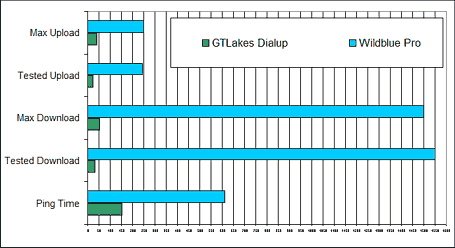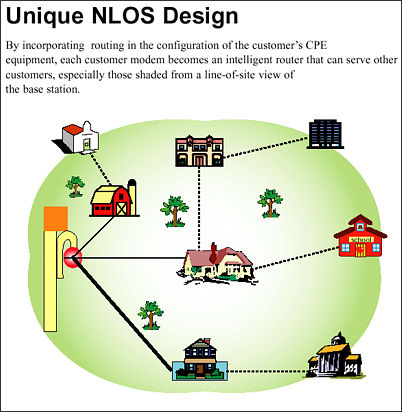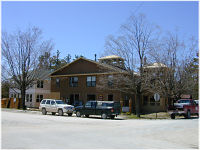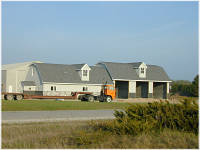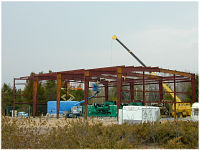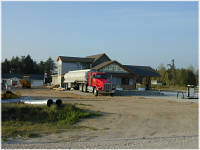|
TDS Telecom delivers ADSL - a dream come true After 8 years of wishing for true low-latency broadband on Beaver Island, TDS has come through in a big way and delivered 1.5 and 3.0 mbps / 512 kbps DSL broadband at last. If anyone is interested in broadband within the following coverage areas, this is the best option we have ever experienced on Beaver Island!
Click here for more information, prices and plans, and real-world performance. WildBlue up and running on Beaver Island and delivering best ever out-of-town Internet After another wonderful summer, with the shorter days of fall ahead my thoughts have once again turned to how to get faster Internet to make the off-season more interesting and productive. Last spring we hoped Maylone Enterprises would bring broadband beyond the line of sight currently served by GLE from the school's roof–as we had hoped Wireless First might do. But while interest has been expressed, no one has organized the support necessary to make this somewhat difficult project happen. Referring to a 100-signature petition asking TDS for a solution, Charlene Burnison said "there is a slim chance TDS will consider providing DSL to Beaver Island in the future." Slim is definitely much much better than none, and we are optimistic that a line-based solution might be found that makes this possible on Beaver Island (those interested in Beaver Island DSL should send a quick email to dean.watkins@tdstelecom.com stating their interest) but this is still likely a ways off and not yet a sure thing. A new option however has finally arrived. We've heard about WildBlue since the year 2000, but based on previous ku-band service (Starband and DirecWay) I was skeptical. Early reports of this first US ka-band consumer satellite service were very positive, so I placed an order, and Midwest Energy had a brand new WildBlue system installed and running smoothly in under 3 hours. WildBlue delivers speeds I haven't seen since using a mainland cable modem: a blazing 1550 kbps down (30 times the download speed of dial-up) and 235 to 255 kbps up (7 times the upload performance of Island dial-up) A 10 MB download that takes a half hour over dial-up is finished in under a minute over Wildblue! While there is 625-750 milliseconds of latency due to the distance of the satellite, things that never worked well over previous satellite systems like ftp and secure sites are very fast and reliable over Wildblue. Installs through an NRTC coop are currently subsidized, equipment costs $299, and the monthly fee is $50, $70, or $80, depending on the speed selected–which can be upgraded or downgraded if needed in the future as well. While not as responsive as wireless, this is by far the best always-on 2-way satellite Internet technology I've experienced to date. If you're interested, give the friendly and helpful people at Midwest Energy a call at (269) 445-1112 or 1-800-492-5989, or visit www.wild-blue.coop. –Jeff Cashman, the Beaver Beacon October 2005
Maylone Enterprises Proposed Broadband Link to Include Beaver Island At the December 22, 2004 Charlevoix County meeting an interesting proposal was made by Maylone Enterprises of Elk Rapids, a proposal that could very well become a major stepping stone to Beaver Island's broadband future. Earlier in the fall, Tim Maylone, president of Maylone Enterprises, was asked by the Charlevoix County Sheriff if there were a way to improve its communications between the Sheriff's office, a Boyne City location, and the Beaver Island substation. There was one small problem–there were no additional funds to spend for this in the current budget. Spending time at the County Building, Maylone noted that currently each desk in the County Building has its own phone line, while only a few of the 88 separate lines were actually in use at any given time. In addition, long distance charges to locations such as Beaver Island do add up. When Maylone asserted that a more flexible network could accomplish the goals at hand, and pay for itself and then some, he was asked to analyze the situation and make a proposal. Maylone Enterprises currently provides 32 Internet hotspots, including networks in and around East Jordan and between Mackinaw City and Mackinac Island. Maylone says he is especially interested in providing broadband and wireless service in Charlevoix County as it would fill the gap in his current coverage between Elk Rapids and Mackinaw. Having gained the County's public safety committee's support to go ahead on December 7th, at the December 22nd County meeting Maylone proposed a strategy combining conventional T1 lines with high-capacity wireless, including wireless broadband links to the Boyne and Beaver Island locations. In addition to providing the desired broadband data connections between the Charlevoix County building, Charlevoix Sheriff's Office, Boyne, and Beaver Island substations, a control box would be placed at each location allowing users the option of automatically making Voice Over Internet Protocol (VOIP) connections to greatly reduce long distance costs. When not possible, it would automatically fall back to the traditional POTS line at each location. Maylone secured private investment to fund all equipment and installation costs so the County would not have to pay any up-front costs, and estimates that "after factoring in the early termination penalties for higher-priced current telcom contracts (which would be made unnecessary by the new infrastructure), even in a worst case scenario the County would begin saving $1,300 per month, the very first month, by utilizing the new system." And "in a best case scenario, as the transition progressed, the savings could grow closer to $2,000 per month" while providing enhanced linkages between the four locations. At this point the issue was sent to committee to put together a new RFP, so it is somewhat unclear what the next month will bring or what the rollout schedule may be. If the County does ultimately decide to go ahead with the proposal from Maylone Enterprises, it could be exciting news for the Island as Maylone has expressed a strong interest in moving forward to provide much more for the Island's community in general. As Maylone works on securing tower space on the mainland for an Island connection, he says, in the future he would like to provide not only fast broadband access to more people than can currently see the school's roof, but more, states that this could be "the cornerstone for also providing better telecommunications for medical applications, Internet2 access for the Island schools, public safety, alternative phone services, and alternative commodities broadband Internet access on Beaver Island."
New Dialup Options and Hopefully Beaver Island Broadband Options Soon. Update: Thank you very much to GLE for doing a wonderful job with the local dial-up switch over, complete as of August 28th, 2002 at 10:00 am, a couple days ahead of schedule even. Those on the Island will now find they are able to connect in the high 40's (45-48 kbps) with compression, instead of being limited to uncompressed 31.2 as we were for the past few years when connecting to BIIP. It does make for a noticeable improvement as expected. Very good job on the Island dial-up GLE, and a big thank you! One small disappointment is that the wireless system (which is great, delivering 300-700 kbps both ways, always-on) is only able to reach 1 mile, not 9 as reported last month. The 9-mile radius mentioned by GLE is under ideal circumstances without any trees and with a tower, and here with the low antenna on the school, 1 mile is the furthest the system is able to reach (as was reported correctly in the spring). Hopefully newer wireless technology (which is starting to emerge, but has yet to be installed by GLE in any of their 15 or so wireless sites) or a tower near the School will enable more people to access the wireless system in the future. Update: Previously we believed that there would be two great new options for local dialup come September 1st: GLE and BIIC. But recently Tim Dwyer of Traverse Technologies and the Beaver Island Internet Company (BIIC) announced with a press release that BIIC will not be rolling out its own local dialup system because he believed they did not receive enough support to launch successfully given provisioning delays which would cause a delay in the availability of the BIIC system past September 1st. Although we have very high hopes for GLE and are overjoyed that they will soon be offering service, it's also unfortunate that BIIC was not able to launch at this time as it's always nice to have options and new local businesses (for example, while GLE says they will support multilinking, satellite, and wireless within a 1 mile radius of the base station, BIIC may have used the faster v.92 modems for those who prefer the low cost of dialup.) Update: BIIP subscribers received a notice that a decision has been made and GLE will be taking over the BIIP dialup customers by September. GLE will be replacing BIIP's existing 24 dialup lines with 48 lines. Hopefully GLE will also allow customers to connect at 56k rather than 31.2 k which would be slight but noticeable improvement in download speeds at least. GLE also said they will offer wireless access to the harbor area, and also within a 9 mile radius of the wireless base station if you can get a clear line of sight to the base station. More details on the GLE's wireless system will be announced shortly.
Broadband might still come to Beaver Island Wireless First Broadband Access Proposal
Wireless First will be able to provide T-1 Internet access to large customers (schools, etc.) for $1000 per month complete. This link would tie directly into their router. Wireless First would deliver via fiber or point-to-point microwave. Customers would provide or pay for router. Residential sites: 256K-$35/mo. Commercial sites with 1 workstation: 256K-$50/mo. Commercial sites with network and shared IP: 256K-$100/mo. Each additional IP address is $15/mo. For more information, contact Jeff Forrest, jforrest@speedconnect.com
Community Internet Technology Forum A few years ago, an interesting thing happened to us on our way to the twenty-first century. In an effort to make Internet service affordable to the Beaver Island School, the original partners of the Beaver Island Internet Project (the School, CMU, and the Medical Center) decided to offer Internet service to everyone on Beaver Island. At that time no one knew what kind of demand there would be. It was hoped twenty or thirty subscribers could be found, enough to help defray the cost.
(Watch for more news soon, and if you have any questions, concerns, or ideas, I would very much like to hear from you. jcashman@beaverisland.net ) Broadband Access is coming to the rest of Michigan In the graphic below (From The Detroit News) Orange (peach) represents areas where Cable Modem service is currently available, offering up to 50x the speed of dialup and always-on convenience. Tan represents areas where DSL is currently available (preferred by some for better quality of service in some areas), and Gray/Blue represents areas where broadband access is planned to be available within 24 months. Now how can we bring better, faster Internet Access to Beaver Island? Interesting Wireless Links:
|
New Large-Scale Construction on the Island |
|
| ||||||||||||||||||||||||||||||||||||||||||||||||||||||||||||||||
